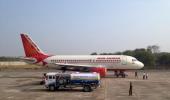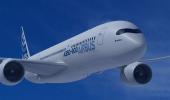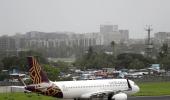It offers a real opportunity for the flag carrier to compete on the world stage, backed by a leading conglomerate with deep pockets like the Tatas, observes Indrajit Gupta.
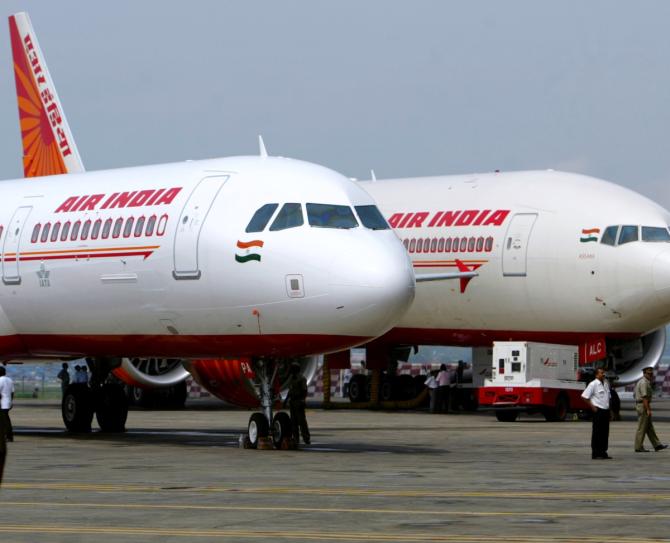
The 470 aircraft deal that the Air India group signed with Airbus and Boeing has understandably generated considerable hoopla and hype.
That's because it finally offers a real opportunity for the flag carrier to step up and compete on the world stage, backed by a leading conglomerate with deep pockets, like the Tatas.
However, this cuts both ways. For the uninitiated, this immediately raises expectations of a better inflight experience.
Many shunned Air India for its shoddy customer service and cabin experience, with broken entertainment systems and seats, unclean interiors and poor choice of food and beverages.
These old loyalists who moved away to other better run global carriers may want to now give Air India a try.
However, new aircraft orders typically have a long lead time -- and Air India was late to the party.
In fact, if it weren't for Aeroflot losing access (due to sanctions) and Qatar (due to a dispute), Air India would have found itself shut out.
Except for the first batch of six out of the 40 Airbus aircraft, originally meant for Aeroflot and likely to be delivered to Air India by the end of this year, most of the new orders aren't expected before 2025, and will be delivered in batches till 2029 and beyond.
Therefore, if this mega fleet acquisition raises customer expectations, managing that will be a tad tricky.
This is just one part of the tightrope walk that the Tatas have had to do ever since their acquisition of Air India in January 2022.
While the intent to fix the airline is clear, the turnaround and integration challenges are nothing less than formidable.
By all indications, it will take at least one more year for the turnaround to be even palpable across the entire customer journey, from reservation and web check-in, to departure and arrival.
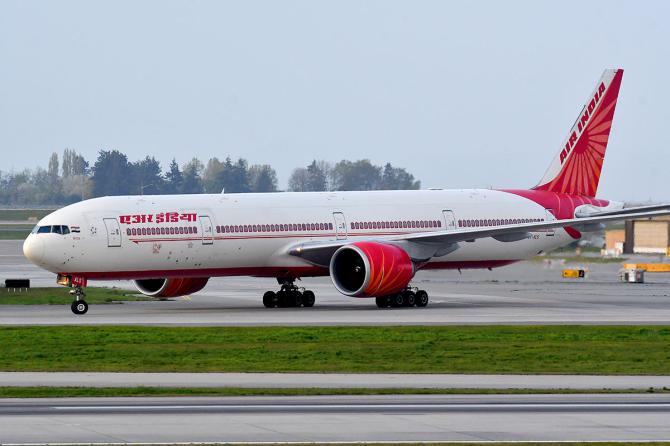
To start with, the Tatas perhaps underestimated the task of fixing the interiors of its existing aircraft and reviving the fleet that remained grounded for lack of spares, and paucity of cash for critical engine overhauls and other maintenance.
Many original equipment manufacturers and vendors went belly up during the pandemic.
Over time, the airline has been able to bring back 10 of the 43 wide-bodied aircraft that had remained grounded and deployed them on more remunerative long-haul routes like Vancouver-Delhi.
Air India, however, is doing the next best thing: It has leased 11 wide-bodied Boeing 777-200 LRs aircraft that Delta had retired at the start of the pandemic.
These fuel-guzzling aircraft were parked in the desert.
Air India was able to lease them at very competitive rates.
The first two aircraft were deployed on the Mumbai-JFK and Mumbai-San Francisco routes this year.
The business cabin experience -- including the cuisine and amenity kits -- is far superior and contemporary than what Air India offered.
All that Air India has done is simply taken off the Delta logo from the upholstery.
There is an unmet demand in some of these sectors.
The Ukraine war has placed restrictions on US carriers -- and they are forced to use a longer route. Air India has no such constraints.
A major refurbishment programme of its existing fleet has been on the cards. It will start to take effect by around March next year and will need to be done in batches of two or three aircraft at a time, so that it doesn't disrupt current operations.
Most major global airlines follow a structured induction programme for its new fleet.
It is seldom possible to absorb anything more than 60-65 new aircraft in a year.
Finding enough trained cabin crew, co-pilots and captains for each new aircraft is a challenging proposition, especially since a stand-by crew needs to be in place.
Air India has been trying to retire staffers in the 50-plus age group and hire and train a younger cohort of cabin crew, particularly from the north east.
Air India is inducting nearly 250 cabin crew every month to deal with the staffing shortage.
Finding enough experienced pilots to man the long-haul Boeing 777 aircraft is proving to be a challenge.
Many pilots did not fly during the two years of the pandemic -- and that raises issues of safety.
On the other hand, the Middle Eastern carriers have recently hired many experienced expat pilots, who have had continuity of service.
Air India may be forced to overlook the continuity of service criteria.
If it opts to hire Russian pilots for deployment on the US and Canada routes, there are doubts whether these pilots will clear security checks and secure visas.
In the next phase of the integration for Air India, Air Vistara and its two budget carriers -- AirAsia and Air India Express -- a new network design will offer new synergies.
For instance, AirAsia is already vacating a few of its landing slots for Air India in a congested airport like Mumbai and moving to serve the feeder routes.
The partnership with Singapore Airlines, which is expected to pick up a 25 per cent stake in the merged entity, will also bring in better connectivity to the traffic coming through Singapore from Australia and New Zealand, possibly through code sharing flights passing through Air India's hubs in Delhi, Mumbai and Bengaluru and vice versa.
Indrajit Gupta is co-founder, Founding Fuel.
Feature Presentation: Rajesh Alva/Rediff.com

